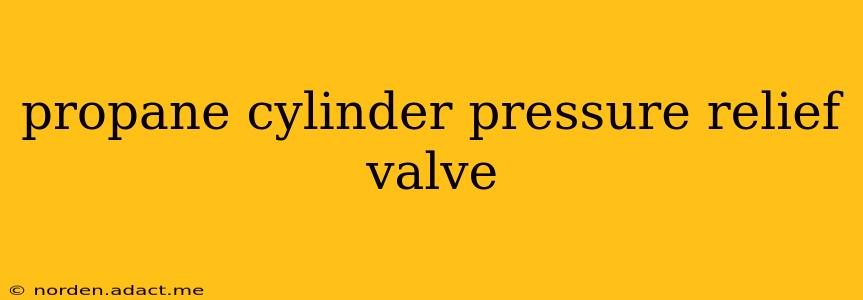Propane, a widely used fuel source for heating, cooking, and various industrial applications, requires careful handling and safety measures. A crucial component ensuring the safe operation of propane cylinders is the pressure relief valve. This valve acts as a crucial safety mechanism, preventing dangerous pressure build-up within the cylinder. This comprehensive guide will delve into the intricacies of propane cylinder pressure relief valves, addressing common questions and concerns.
What is a Propane Cylinder Pressure Relief Valve?
A propane cylinder pressure relief valve is a safety device designed to automatically release excess pressure from a propane cylinder if the internal pressure exceeds a predetermined safe level. This prevents potentially catastrophic ruptures or explosions caused by overheating, fire, or other factors that could increase internal pressure. The valve is typically a spring-loaded mechanism; once the pressure surpasses a set point, the valve opens, releasing propane gas to the atmosphere until the pressure drops back to a safe level.
How Does a Propane Cylinder Pressure Relief Valve Work?
The valve operates on a simple yet effective principle. A spring maintains a certain pressure on a valve disc or plunger. As the pressure inside the cylinder increases, it eventually overcomes the force of the spring. This triggers the valve to open, allowing the excess propane to escape. Once the pressure reduces, the spring pushes the valve back into its closed position, sealing the cylinder. The release of propane is typically accompanied by a hissing sound, serving as an audible warning.
What are the Different Types of Propane Cylinder Pressure Relief Valves?
While the basic function remains consistent, propane cylinder pressure relief valves can vary slightly in their design and application. Some common variations include:
- Fusible Plugs: These valves utilize a metal plug with a low melting point. If the cylinder’s temperature rises excessively (indicating a potential fire or overheating), the plug melts, allowing pressure to escape.
- Spring-Loaded Valves: These are the most common type, employing a spring mechanism to regulate pressure release, as described previously.
- Burst Discs: These valves utilize a thin metal disc that ruptures when pressure surpasses a certain limit.
What Happens When a Propane Cylinder Pressure Relief Valve Opens?
When a pressure relief valve opens, it indicates a potentially dangerous situation within the propane cylinder. The release of propane gas is a crucial safety measure to prevent a more significant incident. If you witness a propane cylinder's pressure relief valve opening, immediately:
- Move away from the cylinder: Maintain a safe distance to avoid potential injury from escaping propane gas or a possible explosion.
- Turn off the propane supply: If possible and safe to do so, shut off the propane supply valve to the cylinder.
- Contact emergency services: Call your local fire department or emergency services immediately.
How Often Should a Propane Cylinder Pressure Relief Valve Be Checked?
Regular inspection of the pressure relief valve is vital for ensuring safety. While there isn’t a standardized frequency for checking, it’s recommended to visually inspect the valve for any signs of damage, corrosion, or leaks during routine propane cylinder maintenance checks. Any signs of damage should warrant professional inspection and potential replacement.
Can I Repair a Propane Cylinder Pressure Relief Valve Myself?
No. Repairing a propane cylinder pressure relief valve should only be undertaken by qualified technicians. Attempting self-repair can be extremely dangerous and may compromise the safety features of the valve. Always contact a certified propane professional for any maintenance or repairs related to propane cylinders and their safety devices.
How Do I Know if My Propane Cylinder Pressure Relief Valve is Working Properly?
It’s crucial to understand that a properly functioning pressure relief valve should not be visibly releasing propane under normal operating conditions. A constantly hissing valve indicates a malfunction that needs immediate attention from a qualified professional. Regular visual inspections for damage, corrosion, or leaks are the best way to monitor the valve's condition.
This guide provides a comprehensive overview of propane cylinder pressure relief valves. Remembering the importance of regular safety checks and seeking professional help when needed is crucial for safe propane handling. Always prioritize safety when working with propane.
